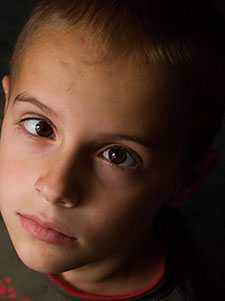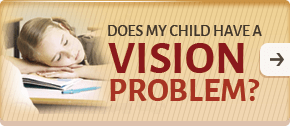Advanced Non-Surgical Treatment for Lazy Eye
Common Name for both Strabismus & Amblyopia
 "Lazy Eye" is a term commonly used to describe both Amblyopia and Strabismus (Eye Turn).
"Lazy Eye" is a term commonly used to describe both Amblyopia and Strabismus (Eye Turn).
Amblyopia means "dull sight" and refers to a condition whereby one eye sees poorly and is effectively blocked out by the visual system. This can cause an eye turn (or Strabismus) but an eye turn doesn't always occur.
Most parents assume because their child can see things in the distance that both eyes must be seeing fine. This is, unfortunately, not always the case. They may actually be only using their one good eye and ignoring the image from the eye that can't see well.
Parents often ask: “but wouldn’t my child know this?” A child may not be aware of this, because they think this is the way that everyone sees. Because they are still able to see out of one eye, they don’t even know to complain!
Because children are often unaware that it is their vision causing their difficulties, it is essential that all children have a comprehensive vision exam before they begin school or as early in the school year as possible.
Childhood Signs of Amblyopia
“Lazy Eye,” or Amblyopia, is easy to miss because there are very few symptoms.
Lazy Eye means that one eye sees poorly, even with eyeglasses. Usually when parents see an eye that doesn’t seem to line up properly, they think that is a “lazy eye.” In fact, that is a condition called an eye turn, or Strabismus. It is important for parents to understand that while amblyopia and strabismus often occur together, you won’t always see an eye wander off when your child has amblyopia.
Some symptoms that might indicate a problem exists include:
- Difficulty in catching or hitting a ball
- Difficulty seeing 3D movies
- Clumsy
- Poor handwriting
The ability to see in 3 dimensions (3D) depends on the coordinated use of both eyes. Thus, people with lazy eye (amblyopia and/or strabismus) will have trouble with activities which require the ability to see depth like:
- Riding a bicycle
- Walking down stairs
- Playing most sports
- Riding an escalator
Strabismus (Eye Turn)
Strabismus is commonly referred to as a “crossed eye” or “wandering eye.” It is a visual condition in which a person is unable to align both eyes simultaneously. When the eyes do not point at the same object at the same time, the result is the appearance of one eye turning in relationship to the other. A person with strabismus has reduced binocular function and depth perception.
Whether the eye turn is constant or intermittent, strabismus always requires treatment. It will not go away on its own, and children will not outgrow it.
 People who have strabismus struggle with visual space orientation. This orientation is a mental phenomenon that exists in the visual cortex of the brain. If left untreated, the eye that turns may also have reduced visual acuity, a condition known as amblyopia or "lazy eye."
People who have strabismus struggle with visual space orientation. This orientation is a mental phenomenon that exists in the visual cortex of the brain. If left untreated, the eye that turns may also have reduced visual acuity, a condition known as amblyopia or "lazy eye."
Treatment for Strabismus & Amblyopia
Treatment for amblyopia is different depending on which doctor you see. Some will tell you that nothing can be done after age 9. However, new research is confirming what we have known for years; thanks to optometric vision therapy, it is never too late to treat a lazy eye! It is definitely true that the earlier amblyopia and other vision conditions are diagnosed, the easier they are to treat and manage. But, even adults well into their 40’s and older can often benefit from vision therapy.
As a parent, it is important to educate yourself on ALL treatment options because children do not outgrow eye turns or lazy eye.
Surgery is not the only way to treat an eye turn. There are more effective treatment options for lazy eye other than patching alone.
Optometric vision therapy has helped many patients achieve better vision in their amblyopic eye and has resulted in straight eyes with 3D depth perception! If you have been told your child is too old to treat, there is still hope. Vision therapy works, no matter how old the patient is.










